Coleridge’s Kubla Khan Poem: Kubla Khan is a poem written by Samuel Taylor Coleridge. It is named after a real Mongolian warrior who lived in an elegant estate and had conquered China.

The topic of the poem itself reminds the images of China and the far east.
The Legendary Story Behind the Poem
Coleridge was reading a book on Xanadu, the summer palace of Mongol ruler and emperor of China, Kublai Khan. He had an opium-influenced dream at that time after which he starts writing the poem. Since he got interrupted by a person from Porlock, the poem could not be completed at that time.

Coleridge had plans of writing a poem of 200 – 300 lines, but due to the interruption, he forgot the lines. As he was not properly satisfied with the poem, he left it unpublished and kept it for private reading till 1816 and only after Lord Byron prompted, he got it published.
Analysis
The speaker of the poem describes Xanadu, the stately pleasure dome, the palace of Kubla Khan. First, he starts with the setting of the palace and mentions about a river that runs across the land and after going through some underground caves, it flows into the sea.
Then the speaker tells about the fertile land around the palace, how the area is covered with streams, trees with appealing fragrance and beautiful forests.
The dome was made of ice and was located in a sunny area. This depicts the contrasting composition of Xanadu. Where there are sunny spots of greenery and deep romantic chasm, amid this hostile nature of the atmosphere, Kubla Khan also hears ancestral voices forecasting war.

A power of dreams and imagination is seen throughout Coleridge’s poem. In fact, it is believed that the most fantastical world created by Coleridge is that in Kubla Khan. The story behind writing this poem is that Coleridge wrote this poem after he had an opium-influenced dream.
Coleridge explored the depths of dream and created a landscape that could not exist in reality. It describes the extreme fantasy, the extremeness of imagination of the world in which Kubla Khan lives.
Coleridge’s Kubla Khan Poem
Just like any other poem of Coleridge, you will find the admiration of nature by the speaker in this poem also. Yet, the most remarkable thing that makes this poem apart from others is the description of dangerous and threatening aspects of nature described here. For example:
But oh! that deep romantic chasm which slanted
Down the green hill athwart a cedarn cover!
A savage place! as holy and enchanted
As e’er beneath a waning moon was haunted
By woman wailing for her demon-lover!
And from this chasm, with ceaseless turmoil seething,
As if this earth in fast thick pants were breathing,
A mighty fountain momently was forced:
Amid whose swift half-intermitted burst
Huge fragments vaulted like rebounding hail,
Or chaffy grain beneath the thresher’s flail:
And ‘mid these dancing rocks at once and ever
It flung up momently the sacred river (lines 12-24)
In most of Coleridge’s works nature signifies nurturing presence, but in “Kubla Khan” nature is presented as rough, dangerous terrain which can be tamed just by the male explorer, Kubla Khan.
The last stanza of the poem was added later in which the speaker longs to recreate Kubla Khan’s pleasure dome ‘in air’. This stanza becomes more personal and mysterious because the poet describes the past visions of the speaker. The creative figure of Coleridge becomes a source of wonder, awe and terror combined.
The style and form of “Kubla Khan” are quite different from the other poems Coleridge had written. Although this was considered incomplete and fragmented, its language is quite stylised giving strong emphasis to sound devices in the two stanzas of the poem. The Victorian critics, however, praised the poem and some even examined aspects related to the background of the poem.
More Info On- Despair by Samuel Coleridge, The Suicide’s Argument, Epigram, Aftermath
